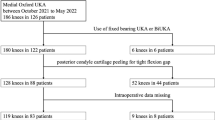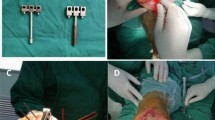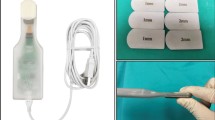Abstract
Purpose
Gap balance is critical in Oxford unicompartmental knee arthroplasty (OUKA) surgery; the effect of lower limb positioning on gap balance judgements has not been reported. There are two mean operative positions for OUKA patients, the hanging leg (HL) and the supine leg (SL) position. This study aimed to investigate the gap balance achieved by current UKA surgical techniques by using a force sensor, to compare the differences in gap balance between the two different positions, and to test whether the difference in gap balance leads to different outcomes in terms of component alignment and early post-operative clinical outcomes.
Methods
This prospective study included 97 knees (76 patients), who underwent OUKA from June 1, 2020, to July 31, 2021, of which 67 knees underwent UKA in the supine leg position and the other 30 in the hanging leg position. When the operator was satisfied with the gap balance, the contact forces between the trial and the spacer block were measured at 90° of knee flexion (flexion gap) and 20° of knee flexion (extension gap) using a pre-developed matrix flexible force sensor. X-rays were reviewed three to five days after surgery. Knee Society Scores (KSS) were obtained at the six month follow-up.
Results
Compared to the HL group, the contact force at the flexion gap was higher in the SL group: 55.15N (SD 43.36N) vs. 34.25N (SD 27.56N) (p < 0.05), whereas in the extension gap, there was no significant difference, 90.19 N (SD 43.36N) in the SL group and 86.72N (SD 43.08N) in the HL group (ns.). The contact force was greater in the extension gap than in the flexion gap in both groups (p < 0.01). The gap balance difference in the HL group was 52.46N (SD 31.33N), which was greater than that of the SL group at 35.03N (SD 19.50N) (p < 0.05). There were no significant differences in component alignment or lower limb mechanical alignment between the two groups. There was no significant difference in pre-operative and post-operative KSS between the two groups, while post-operative KSS was significantly higher in both groups compared to the pre-operative period.
Conclusion
The intra-operative contact forces between the flexion and extension gaps differed in the two groups; the hanging leg position appeared to produce a greater difference in the judgement of gap balance than the supine leg position, but this difference did not adversely affect the alignment of the component or the early post-operative clinical outcome.






Similar content being viewed by others
Data availability
All of the data are available in contact with the correspondence author.
References
Arias-de la Torre J, Valderas JM, Evans JP, Martín V, Molina AJ, Muñoz L, Pons-Cabrafiga M, Espallargues M (2019) Differences in risk of revision and mortality between total and unicompartmental knee arthroplasty. The Influence of Hospital Volume. J Arthroplasty 34(5):865–871. https://doi.org/10.1016/j.arth.2019.01.046
Walker T, Hetto P, Bruckner T, Gotterbarm T, Merle C, Panzram B, Innmann MM, Moradi B (2019) Minimally invasive Oxford unicompartmental knee arthroplasty ensures excellent functional outcome and high survivorship in the long term. Knee Surg Sports Traumatol Arthrosc 27(5):1658–1664. https://doi.org/10.1007/s00167-018-5299-2
Price AJ, Dodd CAF, Svard UGC, Murray DW (2005) Oxford medial unicompartmental knee arthroplasty in patients younger and older than 60 years of age. J Bone Joint Surg Br 87(11):1488–1492
Whiteside LA (2005) Making your next unicompartmental knee arthroplasty last: three keys to success. J Arthroplasty 20(4 Suppl 2):2–3
Saragaglia D, Picard F, Refaie R (2012) Navigation of the tibial plateau alone appears to be sufficient in computer-assisted unicompartmental knee arthroplasty. Int Orthop 36(12):2479–2483. https://doi.org/10.1007/s00264-012-1679-2
Emerson RH, Head WC, Peters PC (1992) Soft-tissue balance and alignment in medial unicompartmental knee arthroplasty. J Bone Joint Surg Br 74(6):807–810
Heyse TJ, Slane J, Peersman G, Dworschak P, Fuchs-Winkelmann S, Scheys L (2017) Balancing mobile-bearing unicondylar knee arthroplasty in vitro. Knee Surg Sports Traumatol Arthrosc 25(12):3733–3740. https://doi.org/10.1007/s00167-016-4241-8
Slaven SE, Cody JP, Sershon RA, Ho H, Hopper RH, Fricka KB (2020) The impact of coronal alignment on revision in medial fixed-bearing unicompartmental knee arthroplasty. J Arthroplasty 35(2):353–357. https://doi.org/10.1016/j.arth.2019.09.038
Kamenaga T, Hiranaka T, Hida Y, Nakano N, Kuroda Y, Tsubosaka M, Hayashi S, Kuroda R, Matsumoto T (2021) Lateral osteoarthritis progression is associated with a postoperative residual tibiofemoral subluxation in Oxford UKA. Knee Surg Sports Traumatol Arthrosc. https://doi.org/10.1007/s00167-021-06729-y
Scott CEH, Wade FA, MacDonald D, Nutton RW (2018) Ten-year survival and patient-reported outcomes of a medial unicompartmental knee arthroplasty incorporating an all-polyethylene tibial component. Arch Orthop Trauma Surg 138(5):719–729. https://doi.org/10.1007/s00402-018-2908-y
Li C, Li T, Zhang Z, Huang H, Chen T, Zhang H (2021) Potential factors in postoperative dislocation of Oxford phase III mobile bearing UKA in Chinese patients: a single-center retrospective study. BMC Musculoskelet Disord 22(1):930. https://doi.org/10.1186/s12891-021-04828-y
Elmallah RK, Mistry JB, Cherian JJ, Chughtai M, Bhave A, Roche MW, Mont MA (2016) Can we really “feel” a balanced total knee arthroplasty? J Arthroplasty 31(9, Supplement):102–105. https://doi.org/10.1016/j.arth.2016.03.054
Goodfellow J, O'Connor J, Pandit H, Dodd C, Murray D (2015) Unicompartmental arthroplasty with the Oxford knee.
Sun X, Hernigou P, Zhang Q, Zhang N, Wang W, Chen Y, Guo W (2021) Sensor and machine learning–based assessment of gap balancing in cadaveric unicompartmental knee arthroplasty surgical training. Int Orthop 45(11):2843–2849. https://doi.org/10.1007/s00264-021-05176-1
Brimacombe JM, Wilson DR, Hodgson AJ, Ho KCT, Anglin C (2009) Effect of calibration method on Tekscan sensor accuracy. J Biomech Eng 131(3):034503. https://doi.org/10.1115/1.3005165
Zhang Q, Wang W, Liu Z, Yue D, Cheng L, Wang B, Guo W (2020) A novel extramedullary technique to guide femoral bone preparation in mobile unicompartmental knee arthroplasty based on tibial cut and overall alignment. J Orthop Surg Res 15(1):92. https://doi.org/10.1186/s13018-020-01598-6
Takayama K, Matsumoto T, Muratsu H, Ishida K, Shibanuma N, Araki D, Matsushita T, Kuroda R, Kurosaka M (2015) The tibia first technique with tensor measurement is useful to predict the soft tissue tension after implantation in unicompartmental knee arthroplasty. Int Orthop 39(4):667–671. https://doi.org/10.1007/s00264-014-2531-7
Suzuki T, Ryu K, Kojima K, Iriuchishima T, Saito S, Nagaoka M, Tokuhashi Y (2015) Evaluation of spacer block technique using tensor device in unicompartmental knee arthroplasty. Arch Orthop Trauma Surg 135(7):1011–1016. https://doi.org/10.1007/s00402-015-2231-9
Matsumoto T, Muratsu H, Kubo S, Kuroda R, Kurosaka M (2013) Intra-operative joint gap kinematics in unicompartmental knee arthroplasty. Clin Biomech 28(1):29–33. https://doi.org/10.1016/j.clinbiomech.2012.09.002
Gustke KA, Golladay GJ, Roche MW, Elson LC, Anderson CR (2014) A new method for defining balance: promising short-term clinical outcomes of sensor-guided TKA. J Arthroplasty 29(5):955–960. https://doi.org/10.1016/j.arth.2013.10.020
Gustke KA, Golladay GJ, Roche MW, Jerry GJ, Elson LC, Anderson CR (2014) Increased satisfaction after total knee replacement using sensor-guided technology. Bone Joint J 96-B(10):1333–1338. https://doi.org/10.1302/0301-620X.96B10.34068
van der Linde JA, Beath KJ, Leong AKL (2018) The reliability of sensor-assisted soft tissue measurements in primary total knee arthroplasty. J Arthroplasty 33(8). https://doi.org/10.1016/j.arth.2018.03.067
Su Z, Wang Z, Chen H (2019) A force line trajectory measuring system and algorithms for unicondylar knee replacement surgery. Annu Int Conf IEEE Eng Med Biol Soc 2019:2217–2221. https://doi.org/10.1109/EMBC.2019.8857007
Ettinger M, Zoch JM, Becher C, Hurschler C, Stukenborg-Colsman C, Claassen L, Ostermeier S, Calliess T (2015) In vitro kinematics of fixed versus mobile bearing in unicondylar knee arthroplasty. Arch Orthop Trauma Surg 135(6):871–877. https://doi.org/10.1007/s00402-015-2214-x
Krackow KA, Mihalko WM (1999) The effect of medial release on flexion and extension gaps in cadaveric knees: implications for soft-tissue balancing in total knee arthroplasty. Am J Knee Surg 12(4):222–228
Koh Y-G, Park K-M, Kang K, Kim PS, Lee YH, Park KK, Kang K-T (2021) Finite element analysis of the influence of the posterior tibial slope on mobile-bearing unicompartmental knee arthroplasty. Knee 29:116–125. https://doi.org/10.1016/j.knee.2021.01.004
Author information
Authors and Affiliations
Contributions
Juncheng Ge and Wanshou Guo designed the study. Binping Ji and Wanshou Guo operated the UKA procedure. Juncheng Ge, Xiaowei Sun, Qidong Zhang, and Changquan Liu did the data collection. Juncheng Ge and Changquan Liu did the data analysis. Juncheng Ge wrote the article. Qidong Zhang,Binping Ji and Wanshou Guo revised the article. All authors read and approved the final manuscript.
Corresponding authors
Ethics declarations
Ethics approval
All procedures performed in studies involving human participants were in accordance with the ethical standards of the institutional and national research committee and with the 1964 Helsinki Declaration and its later amendments or comparable ethical standards. The study was approved by the institutional review board of China-Japan Friendship Hospital (approval number 2020–50-k28).
Consent to participate
Informed consent was obtained from all individual participants included in the study.
Consent for publication
All authors had consented to the submission of the article to the journal.
Conflict of interest
The authors declare no competing interests.
Additional information
Publisher’s note
Springer Nature remains neutral with regard to jurisdictional claims in published maps and institutional affiliations.
Juncheng Ge and Changquan Liu are co-first authors.
Rights and permissions
Springer Nature or its licensor (e.g. a society or other partner) holds exclusive rights to this article under a publishing agreement with the author(s) or other rightsholder(s); author self-archiving of the accepted manuscript version of this article is solely governed by the terms of such publishing agreement and applicable law.
About this article
Cite this article
Ge, J., Liu, C., Sun, X. et al. Gap balance difference of unicompartmental knee arthroplasty between hanging leg and supine leg position: a prospective cohort study. International Orthopaedics (SICOT) 47, 745–753 (2023). https://doi.org/10.1007/s00264-022-05680-y
Received:
Accepted:
Published:
Issue Date:
DOI: https://doi.org/10.1007/s00264-022-05680-y




